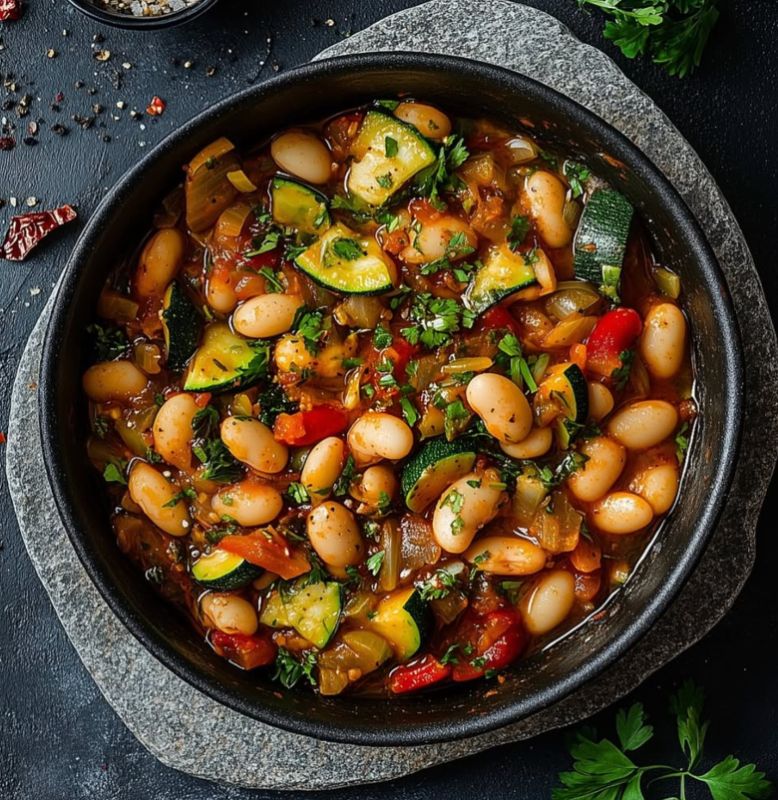🔬 Analysis Report
Original Image

AI-Generated Analysis
✔️ Vegetarian Suitability
The dish appears to be composed of vegetables, beans, herbs, and a tomato-based sauce. There are no visible ingredients that suggest the presence of meat, poultry, fish, or eggs. Since this check is for vegetarian and allows dairy, the fact that no dairy is visible doesn't make the dish unsuitable.
Confidence: Medium
🎯 Targeted Health Analysis
🩸 Sugar & Diabetes
This dish appears to be relatively diabetes-friendly, relying on complex carbohydrates from beans and fiber from vegetables. However, the impact on blood sugar will depend significantly on the amount of added sugar in the tomato sauce, if any. Store-bought tomato sauces can sometimes be high in added sugar. The beans provide a source of complex carbohydrates that are digested more slowly than simple sugars, which helps to prevent rapid spikes in blood sugar. The fiber content further aids in blood sugar control.
Recommendation: Check the label of the tomato sauce for added sugar, or make your own. Monitor blood sugar levels after eating to determine individual response.
❤️ Cholesterol & Heart Health
This dish appears to be relatively heart-healthy. It is low in saturated fat and cholesterol, as it is primarily plant-based. The beans and vegetables provide fiber, which can help lower cholesterol levels. The amount and type of oil used in cooking will impact the heart-healthiness of the dish. Excessive use of saturated fats, such as butter or coconut oil, would be detrimental. The use of olive oil or other unsaturated fats, in moderation, would be beneficial.
Recommendation: Use olive oil or other heart-healthy oil in moderation. Limit or avoid adding cheese or other animal products to the dish.
🧂 Sodium & Blood Pressure
The impact on blood pressure depends heavily on the amount of sodium used in preparing the dish. Store-bought tomato sauces and canned beans can be high in sodium. If a significant amount of salt is added during cooking, this can further increase sodium content. High sodium intake can raise blood pressure. Using fresh ingredients and low-sodium broth can mitigate this concern.
Recommendation: Use low-sodium or no-salt-added canned beans. Make your own tomato sauce or choose a low-sodium variety. Use herbs and spices to flavor the dish instead of salt.
Food Item Identified: White Bean and Vegetable Stew
General Health Assessment: This white bean and vegetable stew appears to be a relatively healthy and nutritious dish. It's likely high in fiber and plant-based protein from the white beans, and rich in vitamins and minerals from the various vegetables. The health impact will depend on the amount of oil and salt used in preparation, which is impossible to determine from the image alone. The presence of a tomato-based sauce suggests antioxidants like lycopene.
⚠️ Important Warnings
Potential Allergen (Onions): Onions can cause digestive upset in people with IBS. (Medium)
Common Visible Components Analysis
White Beans
General Contribution: Primary source of plant-based protein and fiber.
Common Benefits:
- 👍 Promotes satiety
- 👍 Supports digestive health
- 👍 May help regulate blood sugar
Common Drawbacks:
- 👎 Can cause gas or bloating in some individuals
- 👎 May contain anti-nutrients that reduce mineral absorption
Zucchini
General Contribution: Adds vitamins, minerals, and fiber.
Common Benefits:
- 👍 Good source of vitamin C and antioxidants
- 👍 Low in calories
- 👍 Hydrating
Common Drawbacks:
- 👎 None significant at typical consumption levels
Tomato-based Sauce
General Contribution: Provides lycopene, other antioxidants, and flavor.
Common Benefits:
- 👍 Source of lycopene
- 👍 Adds flavor
- 👍 Contains some vitamins
Common Drawbacks:
- 👎 Can be high in sodium, especially if pre-made
- 👎 May contain added sugars
Red Bell Pepper
General Contribution: Adds color, flavor, and Vitamin C
Common Benefits:
- 👍 Very high in Vitamin C
- 👍 Source of antioxidants
- 👍 Adds sweetness and crunch
Common Drawbacks:
- 👎 None significant at typical consumption levels
Onions
General Contribution: Adds flavor and prebiotics.
Common Benefits:
- 👍 Supports gut health
- 👍 Contains antioxidants
- 👍 Adds flavor without adding many calories
Common Drawbacks:
- 👎 Can cause gas in some individuals
Herbs (likely Parsley)
General Contribution: Adds flavor and some micronutrients.
Common Benefits:
- 👍 Contains vitamins and minerals
- 👍 Adds freshness and flavor
- 👍 May have antioxidant properties
Common Drawbacks:
- 👎 None significant at typical consumption levels
❓ What Cannot Be Determined From Photo:
- • The amount of oil used in cooking is unknown.
- • The amount of salt added is unknown.
- • The specific spices used are unknown.
- • Whether the tomato sauce is homemade or store-bought is unknown; store-bought varieties often contain added sugar and salt.
💡 Suggestions & Healthier Alternatives:
- • Use olive oil or another healthy fat in moderation.
- • Use fresh tomatoes and herbs to make your own sauce to control sodium and sugar levels.
- • Add other vegetables like spinach, kale, or carrots for added nutrients.
- • Consider using low-sodium broth or vegetable stock.